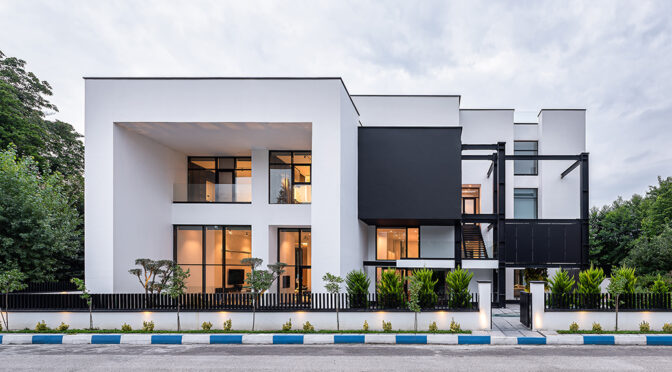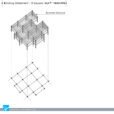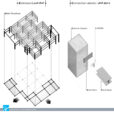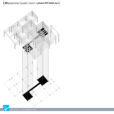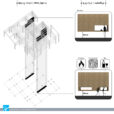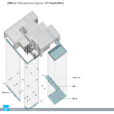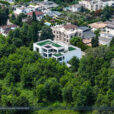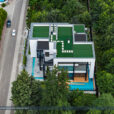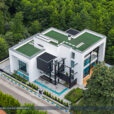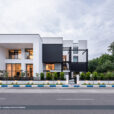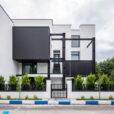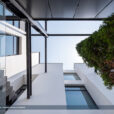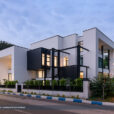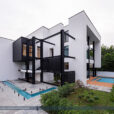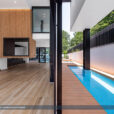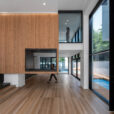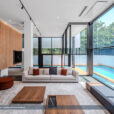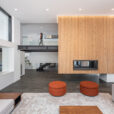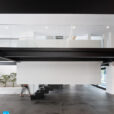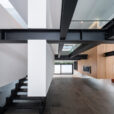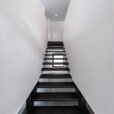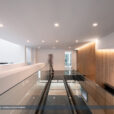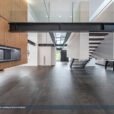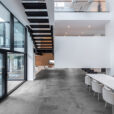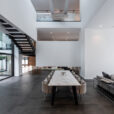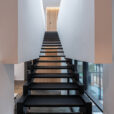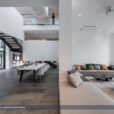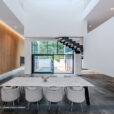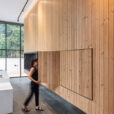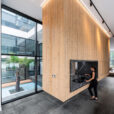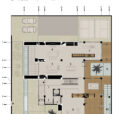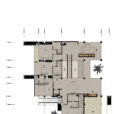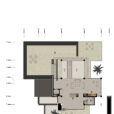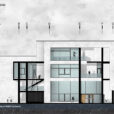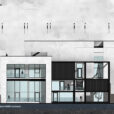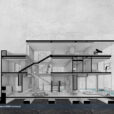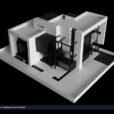ویلای امیردشت
استودیو معماران مادو (مازیار دولتآبادی)
موقعیت: شهرک امیردشت، کلارآباد، مازندران، ایران
تاریخ: ۱۴۰۳
مساحت: ۱،۴۰۰ مترمربع
وضعیت: ساختهشده
کارفرما: امیرحسین قهرمانی
مدیریت طراحی: معین نیکآئین، دنیز ابراهیمی آذر
طراحی داخلی: مرجان میرخشتی، دنیا یوسفی
فاز دو: دنیز ابراهیمی آذر، فائقه خلیلی
مدلسازی: سعید یوسفوند، رویا زراعتکار
ترسیم و گرافیک: سارا رجبی، تینا شاهنظری
سازه و تاسیسات: امیرحسین قهرمانی
اجرا: امیرحسین قهرمانی، اصغر سرمیلی
ماکت: سعید یوسفوند، مرجان میرخشتی
عکس: محمدحسین حمزهلویی
پروژه ویلای امیردشت بازطراحی پروژهای با سبک کلاسیک است که اسکلت آن پیشتر به صورت قاب بتنی اجرا شده بود و کارفرما درخواست تبدیل آن به طرحی مدرن را داشت. در این فرایند، از یکسو، تغییر اساسی ساختمایههای پروژه از مصالح کلاسیک که عموما سنگ است، به مصالح مدرن مانند فلز، بتن و شیشه ضروری به نظر میرسید، و از سوی دیگر، با توجه به اجرای ضعیف اسکلت موجود، هرگونه توسعه طرح نیازمند مقاومسازی سازه بود.

ساختار اسکلت موجود پروژه که مبتنی بر دیاگرام کلاسیک نهمربعی و ترکیببندی شبکهای بود، زمینهای مناسب برای بازطراحی ویلا به سبک مدرنیستهایی همچون لوکوربوزیه، میس وندرروهه و پنج معمار نیویورکی را فراهم آورد. همچنین این بازطراحی فرصتی ایجاد کرد تا برنامه فضایی پروژه بهطور کامل بازتعریف شود. در نتیجه، روابط فضایی طرح پیشین که بیشتر بر اساس تفکیک عملکردی فضاها شکل گرفته بود، در راستای دستیابی به بیشترین میزان سیالیت و آزادی فضایی، مورد بازنگری اساسی قرار گرفت.

توسعه بنا در دو مرحله صورت پذیرفت؛ در مرحله نخست، دو توده مکعبشکل از جبهههای غربی و جنوبی به طرح اضافه شدند که این کار ضمن از بینبردن تقارن دیاگرام کلاسیک طرح پیشین، به کنترل نور جنوب و نیز کجبارانهای جبهه غربی که ورودی اصلی در آن واقع است، کمک کرد؛ در مرحله دوم، یک شبکه اسکلت فلزی به بنا افزوده شد که به سبک مدرنیستها، بهصورت اکسپوز طراحی شده است و بهنوعی میتواند معرف هویت کارفرما باشد که صاحب یک کارخانه اسکلت فلزی است. این شبکه فلزی به عنوان یک سیستم ثانویه فضایی مستقل، همزمان در بیرون و داخل ویلا گسترش یافت، و در بیرون، برای قاببندی درختی قدیمی که در سایت باقی مانده بود، و در داخل، برای تعریف یک نیمطبقه به عنوان اتاق مهمان که با یک پل شیشهای به سایر بخشها متصل میشود، مورد استفاده قرار گرفت.
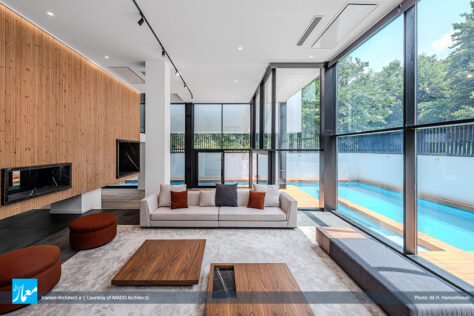
در طبقه همکف که شامل فضاهای عمومی نظیر پذیرایی، نشیمن، آشپزخانه و ناهارخوری است، برای دستیابی به حداکثر شفافیت و ارتباط درون و بیرون که از مولفههای اساسی دیاگرام فضایی مدرن است، از سطوح شفاف شیشهای استفاده شده و این امکان فراهم است که با کناررفتن این سطوح، فضای داخلی بهطور مستقیم با فضاهای تفریحی مانند جکوزی، استخر و حیاط در ارتباط باشد. همچنین برای افزایش سیالیت فضایی، از هیچ دیواری در این طبقه استفاده نشده است، مگر دو دیوار چوبی که از بالاترین طبقه تا طبقه همکف امتداد دارند، اما برای اینکه دید را مسدود نکنند، به زمین نمیرسند. این دیوارها که عناصری نظیر شومینه و بار در پذیرایی، و کابینت و محل آشپزی در آشپزخانه را در خود جای دادهاند، حس تعلیق و سبکی خاصی به فضا میبخشند.

در مرکز پروژه، فضایی تهی با ارتفاع سه طبقه قرار دارد که پلکانهای بنا با فرمهایی مجسمهوار و دیوارهایی معلق درون آن طراحی شدهاند و با ساختاری مشابه یک تفرجگاه، امکان دسترسی کاربران به طبقات بالاتر را در جهات مختلف فراهم میکنند. برنامه توزیع فضاها در طبقات بالای همکف نیز به این صورت است که اتاقهای خواب در طبقه اول قرار گرفتهاند، و شاهنشین که فضایی برای مهمانیها و در ارتباط با بام سبز است، در طبقه دوم قرار دارد.
Amirdasht Villa
MADO Architects (Maziar Dolatabadi)
Location: Amirdasht Complex, Kelarabad, Mazandaran, Iran
Date: 2024
Area: 1,400 sqm
Status: Completed
Client: Amirhossein Ghahremani
Design Management: Moein Nikaeen, Deniz Ebrahimi Azar
Interior Design: Marjan Mirkheshti, Donya Yousefi
Detail Design: Deniz Ebrahimi Azar, Faeghe Khalili
Modeling: Saeid Yousefvand, Roya Zeraatkar
Drawing & Graphic: Sara Rajabi, Tina Shahnazari
Structure & MEP Engineering: Amirhossein Ghahremani
Construction: Amirhossein Ghahremani, Asghar Sormeili
Physical Model: Saeid Yousefvand, Marjan Mirkheshti
Photo: M.H. Hamzehlouei
The project is a redesign of a classical-style structure whose structure had previously been constructed as a concrete frame. The client requested a transformation into a modern design, which required two fundamental modifications: first, replacing classic materials—primarily stone—with modern materials such as metal, concrete, and glass; and second, reinforcing the existing structure due to deficiencies in the previous structure.
The existing structure of the project, based on a classical nine-square diagram and grid organization, provided an ideal foundation for a redesign influenced by modernist architects such as Le Corbusier, Mies van der Rohe, and the New York Five. This redesign also offered an opportunity to entirely redefine the spatial program of the villa. Consequently, the spatial relationships of the previous plan—which were largely dictated by functional separation of spaces—underwent a fundamental reevaluation to achieve maximum fluidity and spatial openness.
The development of the structure proceeded in two phases. In the first phase, two cubic masses were added to the western and southern fronts of the building. This intervention not only disrupted the symmetry of the classical diagram but also improved control over southern sunlight while mitigating the effects of wind-driven rain from the western facade, where the main entrance is located. In the second phase, a steel structure was incorporated into the design, openly exposedو following the modernist approach. This structural addition also served as a visual representation of the client’s identity, given their ownership of a steel-frame manufacturing company. The steel framework, conceived as an independent secondary spatial system, extended both internally and externally. Outside, it was used to frame an old tree preserved on-site, while inside, it defined a mezzanine guest room connected to the main spaces via a glass bridge.
The ground floor houses public spaces such as living room, kitchen, and dining space, was designed to maximize transparency and continuity between indoor and outdoor spaces—an essential component of modern spatial diagrams. Transparent glass surfaces were used to facilitate this openness, allowing the interior to seamlessly integrate with recreational areas such as the jacuzzi, swimming pool, and courtyard when the glass partitions are fully retracted. Additionally, no conventional walls were used on this level except for two wooden partitions that extend from the top floor down to the ground level. These partitions do not reach the floor to avoid obstructing views, and they incorporate functional elements such as a fireplace and bar in the living area, as well as cabinetry and kitchen utilities in the culinary space, creating a distinct sense of suspension and lightness.
At the heart of the project lies a three-story void, around which sculptural staircases and suspended walls are arranged. This spatial composition, reminiscent of a promenade, allows users to navigate different floors dynamically from multiple directions. The upper floors follow a distinct spatial organization: bedrooms are positioned on the first floor, while the Shahneshin—a space dedicated to hosting gatherings and directly connected to the green rooftop—is located on the second floor.

